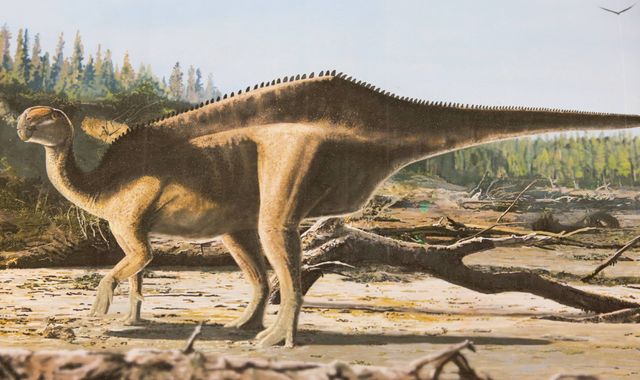
A newly-discovered dinosaur with an "eye-catching sail" along its back and tail is to be named after record-breaking yachtswoman Dame Ellen MacArthur.
Istiorachis macaruthurae was identified and named by Jeremy Lockwood, a PhD student at the University of Portsmouth and the Natural History Museum.
Istiorachis means "sail spine" and macaruthurae is taken from the surname of Dame Ellen, who became famous for setting a record for the fastest solo non-stop round-the-world voyage in 2005.
Dame Ellen is from the Isle of Wight, where the creature's fossils were found.
Before Dr Lockwood analysed them, the fossils, which date back 125 million years, were thought to be from one of the two known iguanodontian dinosaur species from the island.
"But this one had particularly long neural spines, which was very unusual," he said.
Writing in the scientific journal Papers in Palaeontology, Dr Lockwood said his study showed the dino would have probably had a pronounced sail-like structure along its back.
The exact purpose of such features "has long been debated, with theories ranging from body heat regulation to fat storage".
In this case, researchers think it was most likely to be for "visual signalling, possibly as part of a sexual display".
Read more from Sky News:
Trump's been made to look weak
Fight to redraw America's political map
Can Britain's new missile systems protect us?
For the study, the researchers compared the fossilised bones with a database of similar dinosaur backbones which allowed them to see how these sail-like formations had evolved.
Dr Lockwood said his team showed Istiorachis's spines "weren't just tall, they were more exaggerated than is usual in Iguanodon-like dinosaurs, which is exactly the kind of trait you'd expect to evolve through sexual selection".
Professor Susannah Maidment, of the Natural History Museum, said: "Jeremy's careful study of fossils that have been in museum collections for several years has brought to life the iguandontian dinosaurs of the Isle of Wight.
"His work highlights the importance of collections like those at [Isle Of Wight museum] Dinosaur Isle, where fossil specimens are preserved in perpetuity and can be studied and revised in the light of new data and new ideas about evolution.
"Over the past five years, Jeremy has single-handedly quadrupled the known diversity of the smaller iguanodontians on the Isle of Wight, and Istiorachis demonstrates we still have much to learn about Early Cretaceous ecosystems in the UK."

(c) Sky News 2025: New dinosaur named after record-breaking yachtswoman


 Britain is buying new air defence missile systems - but can they protect us?
Britain is buying new air defence missile systems - but can they protect us?
 Shoreham air crash: Families mark 10 years since one of UK's worst airshow disasters
Shoreham air crash: Families mark 10 years since one of UK's worst airshow disasters
 Liberty Steel's Speciality Steels UK pushed into compulsory liquidation
Liberty Steel's Speciality Steels UK pushed into compulsory liquidation
 Why Germany's top football league is turning to this man
Why Germany's top football league is turning to this man



